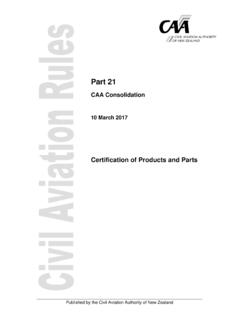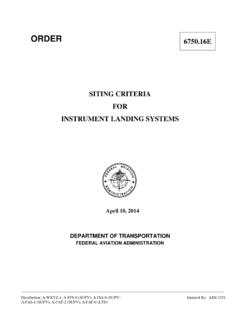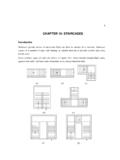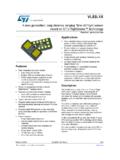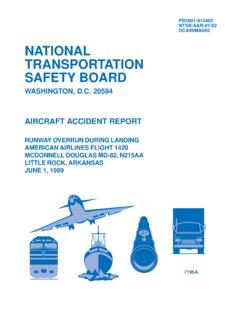Transcription of Take Off and Landing Performance - aviation.govt.nz
1 Take-off and Landing performanceSee the CAA website for Civil Aviation Rules, advisory circulars, airworthiness directives, forms, and more safety publications. Visit effort is made to ensure the information in this booklet is accurate and up-to-date at the time of publishing. But numerous changes can occur with time, especially in regard to airspace and legislation. Readers are reminded to get appropriate up-to-date responsibilities ..5 How to comply ..5 Performance factors ..6 Weight ..6 Air density ..6 Wind ..10 Slope ..12 Surface ..12 Obstacle clearance ..13 Flap setting ..14 Ground effect.
2 14 Wing surface ..16 Tyre pressure ..16 Other considerations ..17 Runway distance ..17 Pilot technique ..17 Speed control ..18 Decision points ..18 Contingencies ..19 Determining Performance ..20 Group rating system ..20P-charts ..22 Aircraft Flight Manual ..30 Air transport operations ..32 Know your ..34 Performance questions ..35A significant number of accidents and incidents occur during take-off and Landing . Ensuring that your take-off and Landing can be conducted within the confines of the runway will significantly contribute to the safety of these critical phases of and Landing performance4 PIC responsibilitiesCivil Aviation Rules clearly indicate that it is the responsibility of the pilot in command to ensure that they operate their aircraft in a safe manner with respect to take-off and Landing Performance .
3 In particular, rule (2) states that A pilot-in-command of an aircraft during the flight, ensure the safe operation of the aircraft and the safety of its . How to complyIf you are operating under Part 91, Advisory Circular 91-3 Aeroplane Performance Under Part 91 provides guidance on how best to comply with rule (2). Essentially, AC91-3 says that you can determine the take-off and Landing Performance of your aircraft by one of the following three methods: Group Rating system; P-charts; or Approved Aircraft Flight Manual 91-3 also provides Performance correction tables for surface type, slope, and contaminated runway surfaces, since this information is often omitted from many light aircraft Flight you are operating under Part 135, there will be specific Performance requirements you will need to meet these are briefly discussed later in this booklet.
4 Note that the group rating system, for instance, is quite conservative and sometimes shows that an aircraft will not fit on to a particular runway when in fact P-chart calculations (which are more precise) show otherwise. It is quite acceptable to select the method that shows that the operation can be performed within the aircraft s Performance of these three methods are discussed, with worked examples, later in this and Landing performancePerformance factorsMany different factors affect aircraft gross weight of the aircraft directly affects stall speed, a 10 percent increase in weight increasing the stall speed by 5 - o ffLiftoff speed is generally about 15 percent above the stalling speed, so an increase in weight will mean a higher liftoff speed.
5 In addition to the higher speed required, acceleration of the heavier aeroplane is slower. Hence, a longer take-off distance will be required. As a general rule of thumb, a 10 percent increase in take-off weight has the effect of increasing the take-off run by about 20 percent. LandingHeavier Landing weights require higher approach speeds, which means the aircraft will have greater momentum and require more runway in which to land and stop. A 10 percent increase in Landing weight has the effect of increasing the Landing distance by about 10 densityAs air density decreases, both engine and aerodynamic Performance of pressure on densityAtmospheric pressure decreases with altitude, because the air near the earth s surface is compressed by the air above it.
6 As altitude increases, air is free to expand and therefore becomes less of temperature on densityTemperature generally also decreases with altitude. This causes the air to contract and become denser. However, the drop in pressure as altitude is increased has the dominating effect on density when compared with the effect of of humidity on densityWater vapour is lighter than air; consequently moist air is lighter than dry air. It is lightest (or least dense) when, in a given set of conditions, it contains the maximum amount of water standard atmosphereA standard atmosphere has been established to enable comparison of aircraft performances, calibration of altimeters and other practical the International Standard Atmosphere a particular pressure and temperature distribution with height is assumed.
7 At sea level the pressure is taken to be hPa and the temperature 15 this average atmosphere, any pressure level has a standard corresponding altitude called the pressure altitude (based on a lapse rate of approximately one hPa per 30 feet at lower levels) and a corresponding temperature called the ISA temperature. Pressure altitude is the height that will register on a sensitive altimeter whenever its sub-scale is set to the standard atmosphere, temperature falls off with height at a rate of C per 1000 feet up to 36,090 feet, above which it is assumed to be constant (see Figure 1).Warm air is less dense than cold air.
8 Thus, when the temperature at any altitude in the atmosphere is higher than the temperature would be in the standard atmosphere at the same altitude, then the air at that altitude will be less dense than in the standard also assumes dry air. In normal conditions, the amount of water vapour in the air does not make a significant difference to its density. However, as warm air can contain much more water vapour than cold air, at high temperatures and high humidity, the reduction in density may become significant and degrade aircraft take-off Performance levelStratus and nimbus cloudsHigh cumulus cloudsMt CookMt EverestCirrus clouds4025201510 5 03530-56-34-25-15-5+5+15-54-443774665726 97843101318 abovesea level(thousands of feet) Temp( C)Pressure(hPa)Relative densityFigure 1: The international standard atmosphere7 Take-off and Landing performanceDensity altitudeDensity altitude represents the combined effect of pressure altitude and temperature.
9 It is defined as the height in the standard atmosphere, which has a density corresponding to the density at the particular location (on the ground or in the air) at which the density altitude is being Performance depends on air density, which directly affects lift and drag, engine power, and propeller efficiency. As air density decreases, aircraft Performance decreases. Density altitude, therefore, provides a basis for relating air density to ISA, so that aircraft Performance can be readily altitude can be calculated by taking pressure altitude and adding (or subtracting) 120 feet for each 1 C above (or below) an aircraft is taking off at a density altitude above ISA sea level, it will still get airborne at the same indicated airspeed as at sea level, but because of the lower density the true airspeed (TAS) will be greater.
10 To achieve this higher speed with the same engine power, a longer take-off run will be effect of a high density altitude on the power developed from the unsupercharged engine is adverse, and less power will be available for take-off. (When taking off from a high density altitude aerodrome, the engine will not even develop the power it is capable of unless the mixture is correctly leaned.)8An increase in density altitude, therefore, has a twofold effect on the take-off: An increased take-off speed (TAS) is required. Engine power and propeller efficiency are approximate effect of these two components on take-off and Landing Performance are: The take-off distance is increased by one percent for every 100 feet of aerodrome pressure altitude above sea level, and the Landing distance by one percent for every 400 feet.







